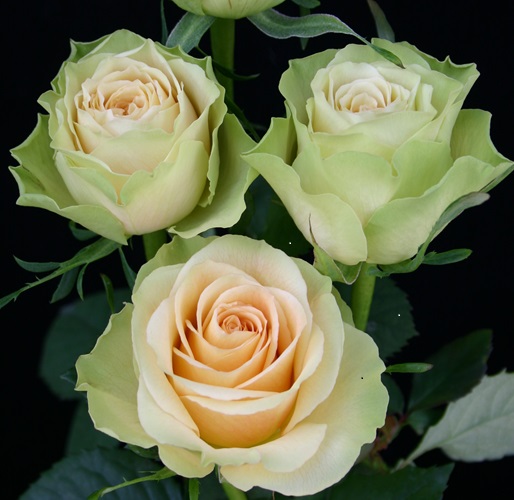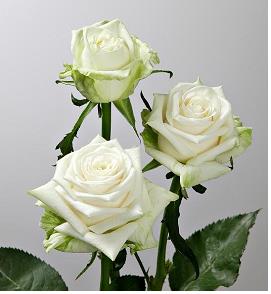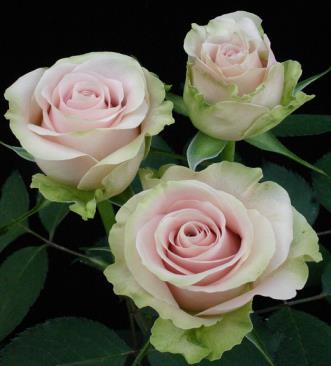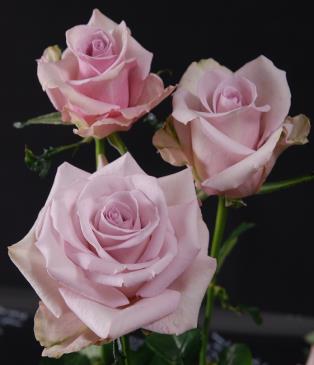Rose breeding
1. The Scientific Basis of Rose Breeding
- Genetic improvements of the rose (concerning the transmission of characters and hereditary) have definitely improved since the Mendel laws of 1875. Since then, the different kinds of roses grown in gardens in China, Persia, Mesopotamia, Japan, Greece, Italy etc. and acquired a great adaptability to the different environments through natural pollination and mutations.
- Every rose breeder has certain more or less definite ideals or objectives toward which his breeding efforts are directed. Some of these ideals are shared by all rosarians, while others express the individuality of the breeder and may or may not find popular acceptance. Apart from improved plant characteristics, for the grower or consumers benefit, the program also focuses on developing innovations to save energy. Breeders intend to improve and increase the following characteristics:
- 1) The range of colors and shades.
- 2) The shape of the bud and of the flower especially at the point of harvesting.
- 3) The elegance of the shape and color of the bud must be accompanied by an adequate and well-proportioned length of the stem.
- 4) The duration of the vase-life of the cut flower.
- 5) The presence of thorns, which customers dislike, is subject to a strict selection.
- 6) The development of new cultivars, preferably red in color.
- 7) The plants productivity and quality.
- 8) The leaf quality.
- 9) The length and strength of the stem is essential, especially with cultivars that have a large flower.
- 10) The adaptability to the different climatic environments around the world as well as different soils.
- Mechanics of Inheritance
- Biologists are agreed that the factors determining the characteristics of plants and animals are serially located in certain deeply staining bodies of the cell nucleus, called chromosomes. Each chromosome contains thousands of genes responsible for the revelation of all the morphological characteristics. With roses, these are, for example, the shape of the leaf, the size of the plant, quantity of thorns, shape of the flower, color and the physiological characteristics such as tolerance to low temperatures, diseases and re-blossoming.
- In the case of somatic cells of rose plants, can be 2n=14 chromosomes, 4n=28 chromosomes and so on. In male sexual cells (in the pollen granules of the anthers) and in the female ones (the oospheres in the ovules inside the ovary) such number is, always half.
- The 28 chromosomes correspond to 14 couples of chromosomes in the somatic cells
2. Conventional hybridization of cut-rose breeding system
- The mother plant select
- The creation of a new rose variety is the result of a breeding and selection process by the casual union of genetic and chromosome complement of the father and mother plant (parents). Initially the parent plants are carefully selected. These are grown, as all the other plants, with sufficient foliage being the green lung through bending to encourage good quality of stems and flowers. Thereafter, the photosynthetic mass or green lung also known as bent foliage is gradually reduced and eventually eliminated after the pollination (all the branches previously bent are cut away). The mother plant or seed-bearer is grown to produce 3-4 flowers per stem to increase the number of subjects (flowers) to pollinate.
- The process of artificial pollination
- During sexual fecundation or breeding, when the breeder (by brushing), puts the pollen of a variety on the stigma of another variety, the number of chromosomes will become double again in all the cells of the new plant. Through a reduction process or meiosis, such number will only be halved in the new sexual cells.

fig. 1 Diagram of rose flower
- The fascinating thing about obtaining new varieties, is that the male chromosomes and the female ones are distributed casually during fecundation, so that inside the new cells (the new plant that will grow from the seed) the morpho-phisiological characters will never be identical to the mother or father plant

Fig. 2 Process of artificial pollination in rose flower
- Once the seed-bearer plant is ready, petals and stamen (male portion) are cut off from the flower. The top of the remaining pistils (stigmas) are brushed, using a small paint-brush, which carries the crossings pollen. Once completed, a label identifying the crossing is attached to the floral stem. Usually, in Korea pollinations are done during April-June
- Hip and seed formation
- After 3 or 4 months the hips are formed. They are therefore picked during the months of September-November. Of the picked false fruits, the achenes are removed with a special small knife. The achenes are immediately sown in lines, in special rook-wool containers (200cells) and covered with slight vermiculite and placed in special dark germination rooms with at 0-4°C. After roughly 2-4 months (this depends on the variety), germination is completed. Thereafter, they are carefully transplanted in small pots and sparingly watered.
- Selection
- The codes are grown in very organized way in test and pre-commercial greenhouses, subjected to a strict supervision. When the plantlets have reached a manageable size they are transplanted in a vase with mixed soil (peatmoss and perlite) and taken to the greenhouse where for about a year, the growth, color, shape and flower-size will be monitored. The plants that appear suitable, will be vegetatively reproduced (via cutting) and grown on rock-wool or coconut peat slab. This is where the first selection phase begins. The stem quality, the growth, the thorns, the leaves, vase-life (in a testing room) and mutations will be tested for about a year. During the next phase, (2nd and 3rd clone-selection phase) the plants that meet the qualities required are reproduced via cutting once again. The characteristics are being monitored for another year. The entire process from sowing to the creation of varieties successful for the grower and the market can take 4 to 5 years.
- During the five years the rose breeding, GARES hybridizers, commercial managers, the technicians, the local and international agents, the major customers and tradesmen, come to the definitive decision for the commercial launching: on an initial population of some fifty thousand seedlings, only 3 or 5 codes receive a name and are patented worldwide, becoming a commercial variety for the international markets.
- It is obvious that these potentially successful varieties have to be tested once more in the different regions and environments.
- Selection in Holland, Kenya and Ecuador
- To sale to worldwide, GARES rose varieties tested in Europe, Africa and South America.
- To reduce the risk of producing varieties of roses that are not suitable for the various regions such as Holland, Kenya and Ecuador tests the varieties for their cultivation areas. By doing so, the varieties bred by GARES in Korea, can be selected for the environment in which they eventually will be grown. The plantlets of the selected varieties are propagated vegetatively (via cutting or via graft) and are gradually bulked up to a number of about 200-300 plantlets. On average the entire selection process can take 3 to 4 years before the varieties can be put on the Market.
- The afore mentioned will clarify that, acquiring new successful varieties, large investments are needed along with many hours of specialist labor (breeder). Furthermore, specialized greenhouse structures and controlled environments for the various breeding and selecting phases are required.
3. The varieties bred by G-Rose Breeding(GARES) in Korea
The varieties bred by G-Rose Breeding(GARES) in Korea
 |
 |
 |
 |
| Geen Beauty |
Deep Purple |
Ice Bear |
Rockfire |
 |
 |
 |
 |
| Silver Shadow |
Love letter |
Venus Berry |
Missing You |
- References
- http://www.bulbnrose.org/Roses/breeding
- http://www.schreurs.nl
- http://www.csulb.edu
- http://deruiter.com
- http://olijrozen.nl
- http://www.nirpinternational.com
- Flower Breeding Technology(ROSE). RDA. 2001.
|